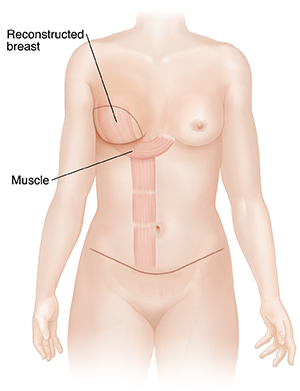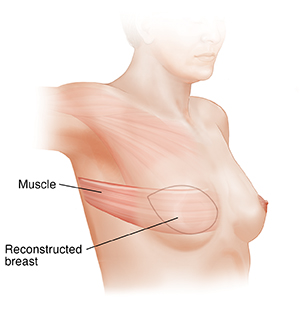Breast Reconstruction with Flap Procedures
A flap procedure uses your own tissue to form the shape of a breast Common types of flap procedures using abdominal tissue are the TRAM and DIEP flaps. The LD flap using back tissue may also be done. Less often, tissue may be moved to the chest from the buttocks or thigh.
These surgeries are named based on what part of the body the flap tissue is taken from.
Tissue flaps look and feel more like natural breast tissue. But flap reconstruction surgeries leave you with 2 surgical wounds. These are the chest and the site where tissue was taken.
Getting breast reconstruction surgery
Your surgeon can help you decide whether to have reconstructive surgery and what type is best for you. You might be advised to wait if now is not the best time for you (delayed reconstruction). For instance, you may be advised to wait if you need to get radiation to your chest after surgery. You may also choose to have breast reconstruction right after your cancer is removed (immediate reconstruction).
Breast reconstruction might not be an option if you smoke, have a connective tissue disease, have uncontrolled diabetes, or have circulation problems. These things can cause blood vessel problems. Healthy blood vessels are needed to support the tissue flap. Some people choose not to have breast reconstruction.
Talk with your healthcare provider about what the surgery is like and what you can expect after surgery. Be sure you know what your breast shape will look and feel like and how the donor flap site might be affected.
TRAM flap
TRAM stands for transverse rectus abdominis myocutaneous. A TRAM flap uses stomach muscle, fat, blood vessels, and skin.
The flap is taken from the lower part of your stomach. It may be tunneled under your skin from your stomach to your chest. Or it may be cut free and moved there. The flap is then formed into the shape of a breast. The new breast shape feels soft to the touch. This surgery also makes your belly flatter and tighter, as if you had a "tummy tuck." It can also decrease the strength in your belly muscles.
 |
| TRAM flap |
DIEP flap
DIEP (deep inferior epigastric perforators) flap uses fat, skin, and blood vessels from your lower belly to rebuild your breast. No muscles are used. Since no muscles are used, DIEP flap may have a shorter recovery time. You may have less risk of losing muscle strength compared with a TRAM flap.
LD flap
The LD (latissimus dorsi) flap uses muscle, fat, and skin from your upper back. The flap of skin and fat is taken from the back side of your body, over your ribs. The latissimus dorsi muscle is left attached to the flap. Then the flap is tunneled under your skin to your chest. There, it's formed into the shape of a breast. The new breast feels soft to the touch. In many cases, an implant is needed with this surgery.
 |
| LD flap |
Nipple reconstruction or nipple tattooing
You may be interested in nipple reconstruction or tattooing. This step is typically done several months after breast reconstruction surgery so the breasts can heal. It's rare for nipple reconstruction to be done during breast reconstruction surgery because the nipples may be positioned poorly. Nipple reconstruction surgery is usually done by a plastic surgeon as an outpatient procedure. The surgeon may use skin from the breast area where the nipple will be. The reconstructed nipple may be tattooed later to add color. You likely won't have feeling in the reconstructed nipple. It may flatten over time.
Some people choose nipple tattooing instead of nipple reconstruction surgery if they don't want another surgery or prefer the appearance of the tattoo. 3D tattooing makes a nipple that appears to have shape but is actually flat. They can also recreate the areola. The tattoo may be done by a staff member at a surgeon's office or a qualified tattoo artist. Wait until you are cleared by your surgeon to have nipple tattooing. Ask your healthcare team if they recommend a certain trained tattoo artist.
Some people may not be able to have nipple reconstruction or tattooing. This includes people who have lymphedema that involves the chest, a history of infections in the breast area, breast skin damaged by radiation, or breast skin that is thin from surgery.
Talk with your healthcare provider about what options they recommend for you. Visit the American Cancer Society at www.cancer.org or breastcancer.org for more information on nipple reconstruction or tattooing.
Risks of flap reconstruction
Any type of surgery has some risk. Some problems linked to breast reconstruction with a flap are:
-
Bleeding
-
Fluid collection in either surgery spot (called a seroma)
-
Anesthesia problems (problems with the medicines used to do the surgery)
-
Bruising and swelling
-
Implant problems
-
Infection
-
Muscle weakness
-
Scars and scar tissue under your skin
-
Blood clots
-
Problems at the donor site, such as muscle weakness or abdominal hernia (with TRAM flap)
-
Loss of the flap because of tissue death
Your surgeon will talk with you about the risks of surgery. Ask all your questions so you understand what breast reconstruction will be like during and after surgery. This way you can make the decision that's best for you.